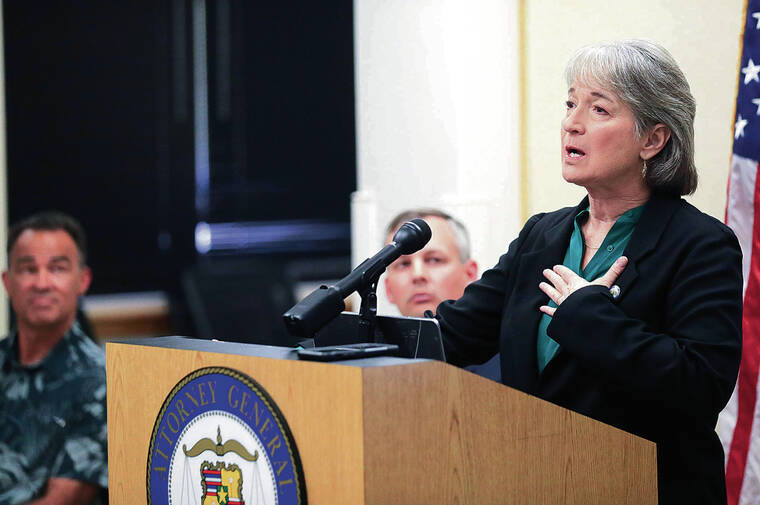
Mahalo for supporting Honolulu Star-Advertiser. Enjoy this free story!
A deadly combination of high wind, power outages, communication failures and a lack of leadership from the Maui Emergency Management Agency created chaos during the Aug. 8 wildfires, according to the first phase of findings from a state investigation.
As fires burned in Olinda, Kula, Pulehu and Lahaina, killing 101 people and leaving 8,000 homeless, police officers and firefighters scrambled, amid rapidly deteriorating conditions, to evacuate homes, and funnel panicked drivers to safety while fighting the flames.
Maui Electric Co. officials were unable to confirm that power lines were deenergized until well after flames had caused widespread devastation.
MEMA’s administrator during the fires, Herman Andaya, was at a conference on Oahu and had his administrative assistant, Gaye Gabuat, in the county’s Emergency Operations Center, texting him updates, according to mobile phone records reviewed by investigators.
MEMA’s mission statement is “Utilizing emergency management principles, we protect all persons within the County of Maui to achieve whole community resiliency.”
Those responsibilities include “planning, preparing, and coordinating emergency management operations in meeting disaster situations and coordinating post-disaster recovery operations.”
Andaya did not return to Maui until Aug. 9 and resigned eight days later. He did not immediately respond to Honolulu Star-Advertiser requests for comment.
Maui Mayor Richard Bissen walked into the county’s Emergency Operations Center between 6 and 6:30 a.m. on Aug. 8.
Bissen remained at the county’s Kalana o Maui building at 200 S. High Street, moving between the EOC on the first floor and his office on the ninth floor, until 2:30 a.m. Aug. 9.
The “vast majority of the time” Bissen was in the EOC, according to county officials.
“We understand the state Attorney General’s investigation and the hard work that Fire Safety Research Institute put into describing the nation’s worst wildfire disaster in modern history,” Bissen said in a statement.
The Phase One report can help piece together what other fire-stricken jurisdictions have called the “most complex megafire they have ever seen.”
“While the investigations and studies can be helpful, the pain, trauma and suffering that our residents have endured continue to be our primary focus,” Bissen said. “I remain committed to bringing Lahaina residents back home so they can take additional steps toward healing.”
Maui Police Chief John Pelletier told the Star-Advertiser that MPD appreciates the “thorough investigation conducted by the Attorney General’s office” and will carefully review the report and work with all stakeholders to learn from Aug. 8 and move forward, transparently.
“The police officers and the firefighters and the other first responders took immediate action and they saved lives. That can’t be understated. People just didn’t just sit there. People took immediate, swift action. They were decisive and they saved lives,” Pelletier said.
The first phase of findings from the state’s investigation, released Wednesday, focuses on the events that occurred “prior to, during, and immediately following the Lahaina fire, such as preparedness efforts, weather and its impact to infrastructure, and other fires” occurring on Maui starting at 2:55 p.m. on Aug. 8 through 8:30 a.m. on Aug. 9.
“Notwithstanding the resilience and the strength of the people of West Maui, the trauma that they endured continues today. And I ask that you be compassionate in the way that you report, you write and you talk about this story,” state Attorney General Anne Lopez said to reporters at the start of Wednesday’s news conference. “A few days after the wildfire I was speaking with the governor, and he and I were asking the same questions that everybody else was, which is ‘how could something like this have ever happened?’”
Lopez and Gov. Josh Green agreed that “good governance demanded we investigate how state and county government functioned during this process.”
“What policies and procedures were in place that worked? Which were in place that didn’t work? And then determining why,” said Lopez.
Lopez was joined by officials from the contractor the state hired to investigate the response to the Aug. 8 fires. Those officials were Steve Kerber, Fire Safety Research Institute vice president and executive director; and Derek Alkonis, FSRI research program manager.
Kerber noted that the fire moved a mile in about 90 minutes and unlike large fires elsewhere, thermal satellite imagery is unavailable to investigators.
Details about how the fire started, spread, and when were determined from civilian photos, videos, fire and police radio traffic, interviews, fire and police chronology reports, and body-worn camera footage from officers.
The investigation into the cause and origin of the Lahaina fire is ongoing.
The Maui Fire and Public Safety Department and the U.S. Department of Justice’s Bureau of Alcohol, Tobacco, Firearms and Explosives are looking into what started the fire and where it began.
ATF’s findings, in their entirety, will be attached to MFD’s cause-and-origin report when the investigations are complete.
Kerber told reporters Wednesday that the ATF is the best agency to determine cause and origin in the world and that the federal agency is likely to share its findings before the one-year anniversary of the fire.
Communication chaos
At 2:55 p.m. Aug. 8, firefighters were dispatched to a report of a fast-moving fire, two days after MEMA posted the Red Flag conditions warning of the increased fire hazard.
“Numerous callers. At the end of the cul de sac on Kuialua. Caller said fire spreading fast.”
“Another caller reporting the same” from Kuialua repeats in numerous entries on the timeline created by FSRI.
At 3:15 p.m. Gabuat texted Andaya that there was a “New fire in Lahaina next to the Intermediate School.”
One minute later, Andaya replied, “oh boy,” and Gabuat responded that the fire is “approaching houses per chief.”
At 3:18 p.m. Andaya asked “Are evacuations underway?”
“Pending per chief’s update,” Gabuat replied.
Maui police were ordered to shut down Lahainaluna Road at 3:21 p.m. Two minutes later, officers blocked access to Lahainaluna Road near Highway 30 as police moved through the neighborhoods asking residents to evacuate immediately.
Officers also blocked access to the bypass road headed into Lahaina near Lahainaluna as the fire approached the roadway. By 3:25 p.m. a patrol officer reported visibility by the overpass of the bypass was “about 5 feet at this point, FYI.”
At 3:29 Andaya sent a text to a group chat that included Bissen, his chief of staff Leo Caires and other Cabinet members about the new fire near the intermediate school.
One minute later, Andaya texted the group that they were closing the bypass road because fire jumped the roadway and “MFD is going to do another evacuation.”
At 3:50 p.m., Mahina Martin, Bissen’s then-communications director, texted Andaya that “pretty chaotic right now for mfd and mpd.”
In between the entries detailing Andaya’s texts is the radio traffic of police and firefighters as they fought the fire, minimal visibility and struggled to save people on streets clogged with debris with traffic choked off in multiple directions.
“There is a lot of smoke,” a patrol officer on Lahainaluna Road told dispatch at 3:50 p.m. Aug. 8.
At 3:53 p.m. Gabuat texted Andaya, “lol chief looks so overwhelm.” The next message to Andaya from Gabuat read “Chief is wanting help from the military. Not sure of what.”
One minute later, Martin texted Andaya “2 priorities now: Evacuate Kulalani and figuring out Westside traffic access/exits.”
Andaya immediately texted Gabuat who was in the EOC, “Manpower?”
“Not sure,” Gabuat responded at 3:54 p.m. on Aug. 8.
At the same time a patrol officer in Lahaina town was ordered to “Yeah stop all the traffic until we can bleed this traffic out from the town area.”
The confusion over evacuation plans and what they lacked was mirrored in the Maui Fire and Public Safety after-action report released Tuesday.
At 3:58 Gabuat texted Andaya, “OMG trying to keep up but too many places are happening.”
Two minutes later, at 4 p.m. Hawaii time, Green, who was on a trip to the mainland, was notified about the fires, according to the FSRI timeline.
“At that time, very little information was available about the extent of the fires on Maui and he (Green) became increasingly concerned about the situation.”
One minute layer Andaya texted Gabuat, “This is crazy,” followed by “How is everyone holding up?”
After being lauded for her work relaying information, Gabuat texted Andaya “I am not sure who is letting the Mayor know but holy moly, chief says this is like hurricane lane.”
The 2020 Hurricane Lane fires on Maui leveled 21 structures, torched 30 vehicles and forced the evacuation of 100 homes.
“There are some that are overwhelmed,” Gabuat texted Lane.
At 4:03 Andaya asked Gabuat by text, “Should I come home?”
After the fire had been burning for more than five hours, Gabuat relayed to Andaya that flames had reached Front Street prompting Andaya to respond that he better “come home tomorrow.”
By that time, multiple areas in Lahaina had been evacuated, a situation report produced by Andaya’s own agency shows.
Front Street had been closed along with the Lahaina bypass road, another key thoroughfare.
In Lahaina alone, 29 utility poles were reported toppled.
Fire crews were trapped by the fire, according to staffing logs included in the report.
Around 4:30 p.m., two engines were destroyed. A firefighter from one of the engines had to rescue the crews using a Maui Police Department SUV.
The preliminary report also describes a breakdown in communication between police responders, firefighters and emergency officials after cellular networks went down.
Both the police and fire departments had to communicate using their handheld or car radios on closed channels that public officials and others could not listen to, according to the report.
Meanwhile, a stretched and limited dispatch center had single operators monitoring five or six channels at a time to keep up with what was happening on the ground.
“With no cellular communication, residents and tourists were not able to receive emergency alerts, communicate with loved ones and/or to receive incoming or outgoing calls/texts,” the report’s authors wrote.
———
The Associated Press contributed to this report.
Read More: World News | Entertainment News | Celeb News
Star Ads









